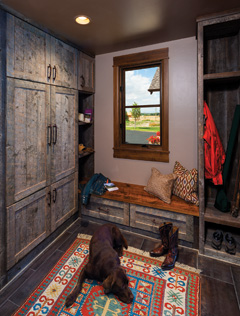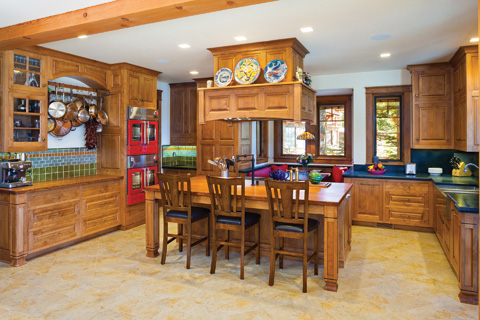We use them for everything from showcasing crystal to storing linens, stacking pots and pans to stowing toiletries. Cabinets are among the most frequently used items in any house, can be a big budget item, and can make or break the look of your kitchen or bath. So it’s no wonder many people have a hard time choosing just the right cabinets! You want cabinets that will enhance the beauty of your home, but they must be durable and easy to care for. You’ll need to consider style, finish, handles, and drawer pulls—the list goes on! Where should you start?
There’s no substitute for expert advice. Enlist the help of a kitchen and bath designer, and make sure your home builder is in on discussions before planning even begins, so that everyone is on the same page.
The National Kitchen and Bath Association’s website, www.nkba.org, is a great resource for inspiration. There is an extensive photo gallery, with stunning examples of not just kitchen and bath cabinets, but wine cellars, entertainment rooms, and more.
Space and Storage
Start by assessing the space you have available for built-in cabinetry, and make that a discussion point right from the start, when you are planning your home design. Consider traffic patterns as well—you don’t want to be walking into an eye-level cabinet every time you round a corner or enter a room.

Photo by Karl Neumann
Don’t underestimate your storage requirements. Have you ever left a cabinet unused? Most of us find ways to fill every space, and then some, so be realistic. If you have a collection of heirloom china or Bavarian beer steins that you want to display, work that into your plans. Even if you’re aiming for a minimalist look, make sure you have sufficient space planned for storing linens and toiletries in your bathroom.
Custom or Stock?
Answering this question will depend on many factors, including budget, the size and shape of your space, and whether you can find stock cabinets that meet your requirements for style, quality, and workmanship.
Stock cabinetry is much less expensive than custom-built cabinets, but you will be limited in your choices to what’s on the market. Semi-custom cabinets give you more control over style, hardware, and configurations while keeping the prices more manageable for many budgets. You can still have add-ons like slide-out drawers and spice carousels with semi-custom cabinets.
With custom cabinets, you get cabinets designed to your specifications, created specifically for your unique home, style, and storage needs. For example, if you want task lighting in the kitchen you can have under-cabinet lighting incorporated as part of the design, rather than added on later. Because cabinets are such an important feature of your home, both visually and in frequency of use, it often makes sense to make an investment in custom cabinets if your budget allows.
Materials & Finishes
Regardless of whether you choose stock, semi-custom, or custom-built, good quality cabinets will have frames and doors made of solid wood. This is especially important in bathrooms and kitchens where the exposure to moisture and temperature variations can negatively impact materials like fiberboard and particleboard.
There are countless door and drawer styles to choose from, plus features like touchless and soft-close drawers and doors. Flat fronts are a clean, modern choice that can instantly update a room, while a raised or recessed panel might make more sense with classic, country, or rustic décor. Glass-front panels allow you to show off your china or pottery collection.

Photo by Karl Neumann
Select a finish that complements the style of your home. The options are nearly limitless—from antiqued patinas to hand-painted designs. If your home has rustic décor, a distressed finish or glaze that lets the wood grain shine through might look perfect, while in a more contemporary home you might choose a dark mahogany stain or even a shiny lacquer finish. In general, lighter finishes make a small space look more open, while darker finishes anchor a large space.
A good rule of thumb is to have a sample door finished, and then keep it in your home for a few days so you can assess it in every light and from every angle. Be cautious about choosing a finish that is going to overpower the rest of the room, unless you want your cabinets to be a focal point.
Hardware
As with door styles and finishes, your hardware should complement your home’s style. At the same time, you want the hardware to contrast enough with your cabinets to stand out. Oil-rubbed bronze, pewter, brass, and copper are striking on wood or even painted cabinets, and can lend an Old World air to your room. You can also coordinate with your appliances: think brushed nickel if you have stainless steel appliances. But there’s no need to limit yourself to metal; beautiful knobs and handles are available in a spectrum of materials from enamel to glass.
Test hardware on actual doors and drawers to assess fit, comfort, and ease of use. Knobs are best on cabinet doors while you’ll want handles on drawers. Your door fronts may allow for hidden hinges, or you may want exposed hinges that are part of the design.
Accessibility
As with every aspect of your home’s design, it’s prudent to consider accessibility and universal design principles when you are planning cabinetry. More people are installing drawers rather than cupboards for their base cabinets, for ease of access. Instead of having to squat down to reach to the back of a cabinet to get to that heavy soup pot, you can simply slide out a drawer and easily lift the pot out. Drawers are especially effective for organizing large items, like pots and pans, bowls and bakeware, with a variety of hardware accessories available to customize storage for your personal needs.

